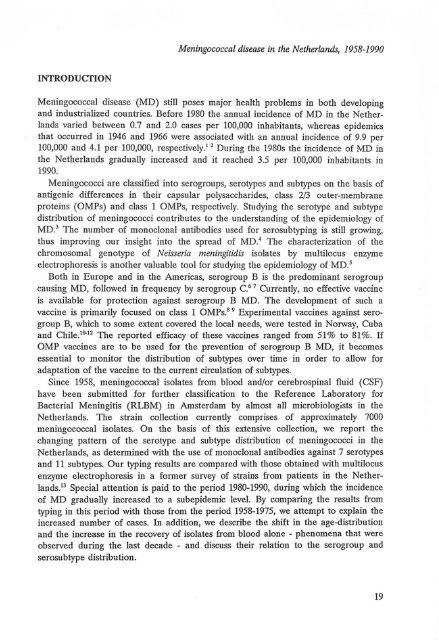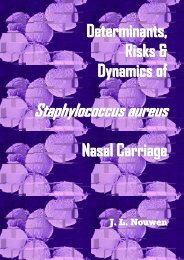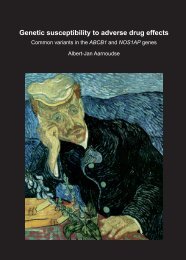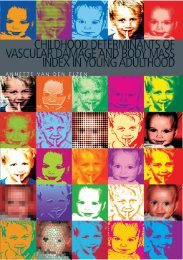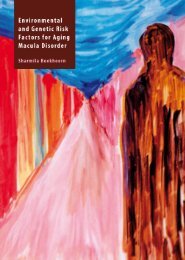An attempt at an epidemiological explanation - Epib.nl
An attempt at an epidemiological explanation - Epib.nl
An attempt at an epidemiological explanation - Epib.nl
- No tags were found...
You also want an ePaper? Increase the reach of your titles
YUMPU automatically turns print PDFs into web optimized ePapers that Google loves.
Meningococcal disease ill the Netherl<strong>an</strong>ds, 1958-1990INTRODUCfIONMeningococcal disease (MD) still poses major health problems in both developing<strong>an</strong>d industrialized countries. Before 1980 the <strong>an</strong>nual incidence of MD in the Netherl<strong>an</strong>dsvaried between 0.7 <strong>an</strong>d 2.0 cases per 100,000 inhabit<strong>an</strong>ts, whereas epidemicsth<strong>at</strong> occurred in 1946 <strong>an</strong>d 1966 were associ<strong>at</strong>ed with all <strong>an</strong>nual incidence of 9.9 per100,000 <strong>an</strong>d 4.1 per 100,000, respectively." During the 1980s the incidence of MD inthe Netherl<strong>an</strong>ds gradually increased <strong>an</strong>d it reached 3.5 per 100,000 inhabit<strong>an</strong>ts in1990.Meningococci are classified into serogroups, serotypes <strong>an</strong>d subtypes OD the basis of<strong>an</strong>tigenic differences in their capsular polysaccharides, class 2/3 outer-membr<strong>an</strong>eproteins (OMPs) <strong>an</strong>d class 1 OMPs, respectively. Studying the serotype <strong>an</strong>d subtypedistribution of meningococci contributes to the underst<strong>an</strong>ding of the epidemiology ofMD' The number of monoclonal <strong>an</strong>tibodies used for serosub typing is still growing,thus improving our insight into the spread of MD.' The characteriz<strong>at</strong>ion of thechromosomal genotype of Neisseria meningitidis isol<strong>at</strong>es by multilocus enzymeelectrophoresis is <strong>an</strong>other valu able tool for studying the epidemiology of MD.'Both in Europe <strong>an</strong>d in the Americas, serogroup B is the predomin<strong>an</strong>t serogroupcausing MD, followed in freq uency by serogroup C' 7 Currently, no effective vaccineis available for protection against serogroup B MD. The development of such avaccine is primarily focused on class 1 OMPs.69 Experimental vaccines against serogroupB, which to some extent covered the local needs, were tested in Norway, Cuba<strong>an</strong>d Chile. I " 12 The reported efficacy of these vaccines r<strong>an</strong>ged from 51 % to 81%. ITOMP vaccines are to be used for the prevention of serogroup B MD, it becomesessential to monitor the distribution of subtypes over time in order to allow foradapt<strong>at</strong>ion of the vaccine to the current circul<strong>at</strong>ion of subtypes.Since 1958, meningococcal isol<strong>at</strong>es from blood <strong>an</strong>d/or cerebrospinal fluid (CSF)have been submitted for further classific<strong>at</strong>ion to the Reference Labor<strong>at</strong>ory fo rBacterial Meningitis (RLBM) in Amsterdam by ahoost all microbiologists in theNetherl<strong>an</strong>ds. The strain collection currently comprises of approxim<strong>at</strong>ely 7000meningococcal isol<strong>at</strong>es. On the basis of this extensive collection, we report thech<strong>an</strong>ging p<strong>at</strong>tern of the serotype <strong>an</strong>d sub type distribution of meningococci in theNetherl<strong>an</strong>ds, as determined with the use of monoclonal <strong>an</strong>tibodies against 7 serotypes<strong>an</strong>d 11 subtypes. Our typing results are compared with those obtained with multilocusenzyme electrophoresis in a former survey of strains from p<strong>at</strong>ients in the Netherl<strong>an</strong>ds13 Special <strong>at</strong>tention is paid to the period 1980-1990, during which the incidenceof MD gradually increased to a subepidemic level. By comparing the results fromtyping in this period with those from the period 1958-1975, we <strong><strong>at</strong>tempt</strong> to explain theincreased number of cases. In addition, we describe the shift in the age-distribution<strong>an</strong>d the increase in the recovery of isol<strong>at</strong>es from blood alone - phenomena th<strong>at</strong> wereobserved during ti,e last decade - <strong>an</strong>d discuss tlleir rel<strong>at</strong>ion to the serogroup <strong>an</strong>dserosubtype distribution.19


